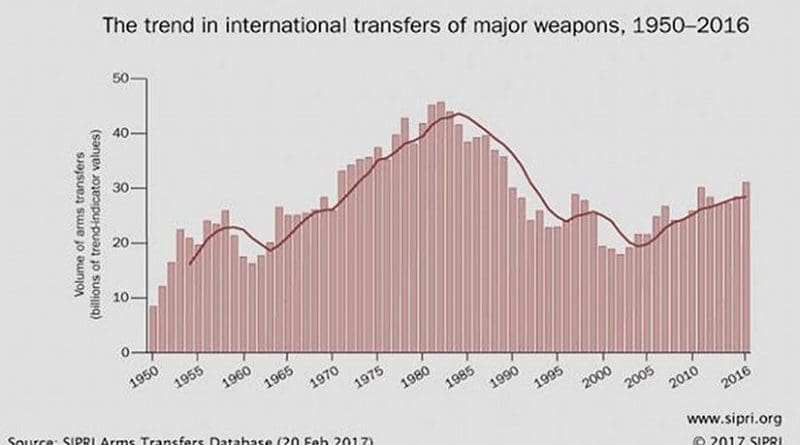Global Arms Trade Hits Highest Level Since Cold War Ended – Analysis
By IDN
By Phil Harris
With the global arms trade having reached its highest level since the end of the Cold War, the United States leads the list of countries transferring major weapons, and flows have increased to the Middle East, Asia and Oceania.
Releasing its latest figures on arms transfers, the Stockholm International Peace Research Institute (SIPRI) said February 20 that the volume of international transfers of major weapons has grown continuously since 2004 and increased by 8.4 percent between 2007-2011 and 2012-2016.
Of the five major arms exporters – United States, Russia, China, France and Germany – the United States accounted for a one-third share of exports, representing an increase of 21 percent over 2007-2011 and almost half of these going to the Middle East, according to SIPRI. Together, exports from the five major arms exporting countries comprised 74 percent of the total volume.
“The USA supplies major arms to at least 100 countries around the world – significantly more than any other supplier state,” said Aude Fleurant, Director of the SIPRI Arms and Military Expenditure Programme. “Both advanced strike aircraft with cruise missiles and other precision-guided munitions and the latest generation air and missile defence systems account for a significant share of US arms exports.”
Russia accounted for a 23 percent share of global exports in the period 2012-2016, with 70 percent of its arms exports going to four countries – India, Viet Nam, China and Algeria – while China’s share of global arms exports rose from 3.8 to 6.2 percent, firmly establishing it as a top-tier supplier, like France and Germany which accounted for 6 percent and 5.6 percent, respectively.
Arms imports by states in the Middle East are reported to have risen by 86 percent in the last 10 years and accounted for 29 percent of global imports in 2012-2016. Saudi Arabia was the world’s second largest arms importer in this period, with an increase of 212 percent compared with the previous five-year period, and imports of arms by Qatar rose by 245 percent. Although at lower rates, the majority of other states in the region also increased arms imports.
“Over the past five years, most states in the Middle East have turned primarily to the USA and Europe in their accelerated pursuit of advanced military capabilities,” said Pieter Wezeman, senior researcher with the SIPRI Arms and Military Expenditure Programme. “Despite low oil prices, countries in the region continued to order more weapons in 2016, perceiving them as crucial tools for dealing with conflicts and regional tensions.”
Meanwhile, arms imports by states in Asia and Oceania have increased by 7.7 percent and accounted for 43 percent of global imports in 2012-2016. India was the world’s largest importer, accounting for 13 percent of the global total, and its imports were far greater than those of regional rivals China and Pakistan.
Imports by countries in Southeast Asia have increased by 6.2 percent, with Viet Nam leaping from being the 29th largest importer in 2007-2011 to the 10th largest in 2012-2016. Its arms imports increased by a staggering 202 percent.
“With no regional arms control instruments in place, states in Asia continue to expand their arsenals,” said Siemon Wezeman, another senior researcher with the SIPRI Arms and Military Expenditure Programme. “While China is increasingly able to substitute arms imports with indigenous products, India remains dependent on weapons technology from many willing suppliers, including Russia, the USA, European states, Israel and South Korea.”

